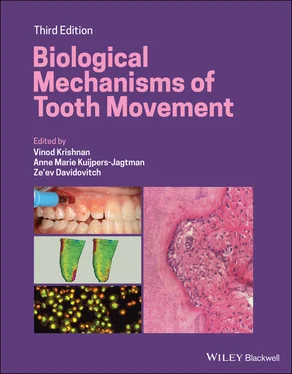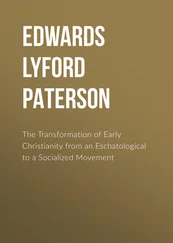Table 4.1 Difference in response of PDL and alveolar bone to light and heavy forces.
| Time |
Light pressure |
Heavy pressure |
| < 1 s |
PDL fluid compressible, alveolar bone bending leading to release of signals. (Piezoelectric and streaming potentials.) |
PDL fluid compressible, alveolar bone bending leading to release of signals. (Piezoelectric and streaming potentials.) |
| 1–2 s |
PDL fluid expressed and tooth movement occurs utilizing PDL space. |
PDL fluid expressed and tooth movement occurs utilizing PDL space. |
| 3–5 s |
PDL cells and fibers are mechanically distorted. Blood vessels will become partially compressed on pressure side and dilated on tension side. |
PDL blood vessels on pressure side become occluded. |
| Minutes |
Blood flow is altered leading to changes in P O 2(partial pressure of oxygen). Release of first messengers (prostaglandins and cytokines). |
Blood flow cut off due to excessive pressure. |
| Hours |
Metabolic changes, enzyme release, release of second messengers leading to rapid cellular activity. |
The compressed area shows signs of cell death (necrosis and hyalinization). |
| Approx. 4 hours |
Increase in level of second messengers (cAMP and others). Increased cellular differentiation within PDL. |
Cellular differentiation occurs in adjacent unaffected areas. Beginning of undermining resorption. |
| Approx. 2 days |
Tooth movement begins as bone remodeling progresses. |
Continuing undermining resorption. |
| 7–14 days |
|
Undermining resorption removes lamina dura adjacent to PDL and tooth movement occurs. |
Proinflammatory cytokines, such as interleukin‐1 (IL‐1) and tumor necrosis factor‐α (TNF‐α), have been shown to be involved in the cascade pathways to elicit acute and chronic inflammation. These cytokines are also involved in bone remodeling (Davidovitch et al ., 1988). Literature regarding this suggests that peripheral nerve fibers and neurotransmitters are involved with the inflammatory process and bone remodeling. Mediating substances in neurogenic inflammation such as calcitonin gene‐related peptide (CGRP) and substance P (SP), have also been proposed to be involved with many inflammatory processes like vasodilatation, increased microvascular permeability, production of exudate, and increased proliferation of endothelial cells and fibroblasts (Vandevska‐Radunovic, 1999).
Different types of neurotransmitters have also been shown to contribute either directly or indirectly to the regulation of osteoblasts and osteoclasts. These neurotransmitters include: CGRP, SP, vasoactive intestinal polypeptide (VIP) and nitric oxide. The various neurotransmitters are synthesized within the ganglion sensory cells before being distributed throughout the central and peripheral nervous system. Release of these neurotransmitter substances is stimulated by the activation of mechanoreceptors or nociceptors (Nicolay et al ., 1990). These neurotransmitters then help in generating cyclic adenosine 3´,5´‐monophosphate (cAMP) and inositol triphosphate (IP3), which act as second messengers within the cells (Sandy et al ., 1993). The intracellular second‐messenger molecules transmit their signals to the nucleus via a series of enzymatic reactions. The stimulated nucleus synthesizes the immediate early genes (IEG), depending on the differing signals received. These IEGs have been identified as c‐fos, c‐jun and egr‐1 . The IEGs are eventually translated into activator protein‐1 (AP‐1), which is a transcription factor that modulates the activity of the gene to which it binds, the effect of which is to produce proliferation or differentiation of the cells (Dolce et al ., 2002).
Increased blood vessel dilation and permeability are necessary components of the inflammatory process and are therefore involved with bone remodeling. Migration and chemotaxis of leukocytes extravasated from the blood vessel lumens are also necessary processes in bone remodeling (Davidovitch et al ., 1988). The converse is also true. Any inhibition of leukotriene or prostaglandin synthesis will inhibit inflammation and bone remodeling. Monocytes, lymphocytes, and mast cells have been shown to express neuropeptide receptors on their cell surfaces, and therefore it has been postulated that CGRP and SP may have a direct influence on the inflammatory process. With this evidence in hand, the peripheral nervous system has been proposed to act as a link between physical stimuli and biological responses in tooth movement.

Figure 4.1 Initial effects of orthodontic forces on paradental tissues.
The hypothesis proposed by Davidovitch et al . (1988) suggests that the mechanical stress, which distorts the cells and matrix of the paradental tissues, imparts strain to the nerve fibers in these tissues, leading to the release of vasoactive peptides from the nerve endings. As previously mentioned, this hypothesis is also supported by the recent discovery of the role of DAMPs in the genesis of inflammation in response to tissue stress or damage (Chen and Nunez, 2010), which can comprise mechanical distortion and hypoxia resulting from orthodontic force application. The vasodilatation produced leads to plasma exudate formation, and migration of leukocytes out of the capillaries. In parallel, inflammatory mediators are essential to generate the local signals that confer specificity to the diapedesis and chemotaxis processes. The leukocytes that then occupy the extravascular space in the involved tissues release cytokines and growth factors to stimulate PDL and bone remodeling ( Figure 4.1).
Inflammatory mediators in OTM
The transduction of mechanical forces to the cells triggers a biological response that has been described as an aseptic inflammation because it is mediated by a variety of inflammatory cytokines and does not represent a pathological condition. In contrast to chronic inflammatory responses, in which persistent stimuli sustain a long‐lasting inflammatory response and result in tissue damage, the expression of inflammatory mediators after orthodontic force application is transitory and essential for orthodontic movement, as anti‐inflammatory drugs are capable of blocking tooth movement. The concept of aseptic inflammation was recently strengthened by discovery of the DAMPs system, where endogenous molecules are able to trigger inflammatory response by cellular stress or damage through the binding of toll‐like receptors (TLRs) and nod‐like receptors (NLRs) (Chen and Nunez, 2010). This tissue response initially involves vascular changes, followed by the synthesis of prostaglandins, cytokines, and growth factors. Finally, such mediators are believed to activate tissue remodeling, characterized by selective bone resorption or deposition in compression and tension regions of the PDL, respectively (Garlet et al ., 2007). Various inflammatory mediators, identified to date, associated with OTM, are summarized in Table 4.2.
Table 4.2 Inflammatory factors from PDL in response to OTM.
| In vitro studies (stimulated by mechanical stress) |
In vivo studies |
| Prostaglandin E 2(PGE 2) |
Prostaglandin E 2(PGE 2) |
| cAMP |
cAMP, cGMP |
| IL‐1β |
IL‐1α |
| IL‐6 |
IL‐6 |
|
TNF‐α |
| RANKL |
RANKL |
| MMP‐1, 2 |
MMP‐1, 2, 3, 8, 9, and 13 |
|
CGRP and SP |
Читать дальше













